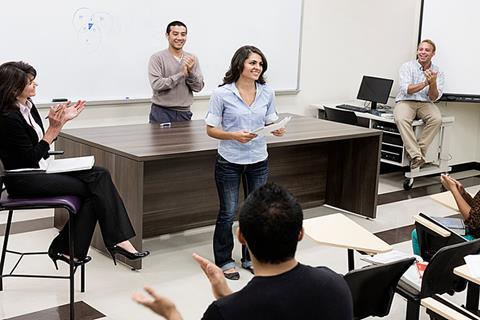This lesson idea looks at how to stimulate autonomy in your classes.

Lesson Idea 7: Learner autonomy: Biography quiz
Tools needed for this class:
- The internet
- PowerPoint (or another presentation tool)
Device: Laptops (minimum one per group)
Other materials:
- Explanatory material, examples and exercises for the grammar area ‘simple present and past’ (you can use a syllabus for this); examples of biographies
- List of famous people: www.biographyonline.net/people/famous-100.html
Main activity: Students write a biography about someone famous they admire, make it into a presentation without the name of the famous person and present it to the group. The group has to guess who the famous person is.
Time needed: 1+ hours
Preparation: Prepare the task explanation and criteria for the students. In this lesson you will use the ‘whole task first’ approach, where students are given all the details about the task and the criteria at the start of the lesson (further details about this approach below). You should explain the main activity (as above) and give them a list of the following things they must include in the presentation:
- nationality
- date of birth (and death if applicable)
- appearance
- notable achievements
- other important or interesting things the person has done
- pictures or illustrations
Tell students it is important not to mention the famous person’s name until the last slide. The aim of the game is to guess who the person is from the information, so they should try to use facts or information that not everyone knows.
The ‘whole task first’ approach
This allows students to work at their own pace and in their own way within a framework. It works like this: as the task and criteria is given immediately at the beginning of the lesson, the stronger students can get started straight away. This creates more space, so that the teacher can spend more time with students who need extra explanations or would like to the task to be broken up into sub-tasks. By giving the whole task first, it creates a context for the sub-tasks for the students, which helps to focus on the content. The students now know why they are studying the grammar or why they need the vocabulary. This is because it becomes apparent very quickly which gaps in knowledge the students have. Students ask much more often ‘how do I say this?’ rather than ‘what is the answer to question 4?’. The language becomes much more function based, thus increasing motivation and encouraging deeper learning.
For the teacher, the ‘whole task first’ approach has two incredibly practical advantages. Firstly, there is little extra preparation. You can use all of the exercises you normally use, but you just change the order. You still use the grammar and vocabulary sub-tasks from the syllabus (if you use one), but by offering these AFTER the task explanation they are used by students in a different way. You have created a learning need: the students ‘need’ the knowledge in order to complete the task.
Secondly, this approach allows individual needs to be met with just one task. The teacher can see immediately which students need extra support and which students can be left alone. It also creates opportunities to talk to students about the process of working and not just about the end product. By using this approach, students are not just learning English, but they are also learning the best ways for them to learn. This learning to learn will help them in becoming more autonomous learners.
Step-by-step guide
Step One (5 mins)
Explanation: Hand out task explanation and criteria.
Step Two (15 mins)
Play the game: Play the example game with your students. Explain that they are going to create their own. Explain the criteria. Allow students who feel confident to complete the task to go ahead and start.
Step Three (15 mins)
Explain sub-tasks (grammar and vocabulary) to the remaining students, and give any explanations needed.
Step Four (30 mins)
Spend the rest of the time helping students and giving feedback to those who have completed the task (they may need to complete the sub-tasks if their work isn’t up to scratch).
Rounding off
Play the finished and approved biographies, either now or at a later date, and see if students can guess each other’s celebrities!
Digital tool selection: Introduction
- 1
- 2
- 3
 Currently reading
Currently readingDigital tool selection: Learner autonomy
- 4
- 5
- 6
- 7
- 8









No comments yet